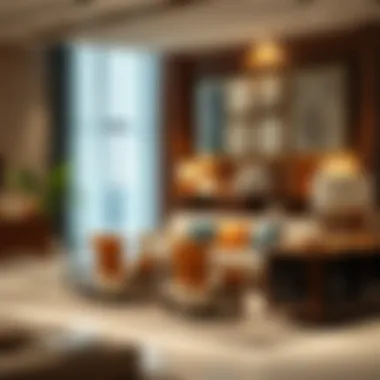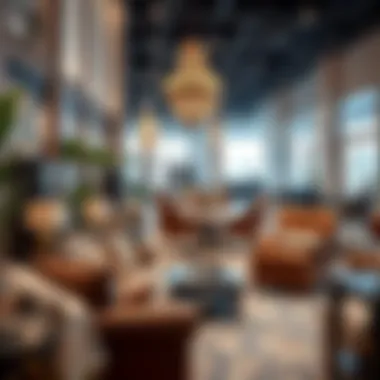Insights into Dubai's Diverse Furniture Market


Intro
The furniture market in Dubai presents a riveting mosaic that captivates professionals and homeowners alike. At first glance, one might think it’s all glitz and glamour, but dig a little deeper and one finds layers of culture, innovation, and enduring economic factors driving this vibrant industry. With the growing influence of expatriates, local artisans, and international brands, it's no wonder that this market reflects the dynamic personality of Dubai itself.
As anyone who's spent time here knows, furniture isn’t just about functionality—it's about lifestyle, art, and a dash of opulence. In this exploration, we will uncover the distinctive characteristics of the furniture scene, and shine a light on the forces shaping its evolution. Whether for investors seeking an edge in this competitive landscape, or homeowners wanting to furnish their spaces with purpose, understanding this multifaceted market is key. Let’s embark on this journey together, as we delve into current trends, economic influences, and future prospects in Dubai's furniture market.
Industry Insights
Current Market Trends
In the ever-evolving landscape of Dubai’s furniture sector, trends shift like sand in the desert. For instance, there’s been a noticeable surge in demand for sustainable and eco-friendly furniture. Consumers are becoming increasingly mindful of the environmental impact of their purchases. Hence, brands producing furniture from reclaimed materials or those with minimal carbon footprints are gaining traction. Additionally, there’s a clear split between luxury and budget segments.
"Sustainable choices are no longer just a trend; they are becoming a necessity, especially in the vibrant fields of Dubai."
Moreover, smart furniture—think integrated technology that simplifies life—has also taken a front seat. From sofas with built-in speakers to tables that charge your devices, the marriage of technology and furniture is an exciting frontier. Another trend worth noting is the mixed-use space designs that embrace both functionality and aesthetics. Homeowners are increasingly looking for pieces that not only serve a purpose but also tell a story or serve as a work of art.
Economic Factors Influencing Real Estate
The pulse of the furniture market can often be felt through the broader economic climate in Dubai. The real estate boom has had a cascading effect on furniture demand. New developments and luxury housing projects—notably in areas like Dubai Marina or Downtown—have heightened the appetite for upscale home furnishings. Changes in expat demographics and increasing tourism also create a ripple effect, further enriching the furniture market.
Contrarily, fluctuations in oil prices and global economic uncertainties can have adverse implications. When times are tough, luxury spending often faces cuts. Investors need to stay sharp on these trends, adapting their strategies as economic tides change.
Another aspect worth considering is regulatory frameworks and local policies that influence both real estate and retail markets. The government's focus on creating a business-friendly environment can present new opportunities for furniture retailers and investors. Keeping an eye on policies that affect import tariffs, trade agreements, and real estate can help one navigate this complex landscape more effectively.
Investment Strategies
Tips for First-Time Investors
For those looking to dip their toes into the Dubai furniture market, understanding market dynamics and cultural nuances is essential. Here are some practical insights:
- Know Your Audience: Understand the demographics you’re targeting. Expatriates might have different tastes compared to local consumers.
- Location Matters: Assess the performance of areas—having a store in a bustling district can offer significant foot traffic.
- Quality Over Quantity: Focus on high-quality products that resonate with the market’s demand for durability and style.
- Embrace E-commerce: The digital shift presents excellent opportunities. Many consumers prefer shopping online, making it essential to have a strong online presence.
Risk Assessment and Mitigation
Investing in the Dubai furniture market comes with its share of risks. Yet, with careful planning, these can be mitigated:
- Market Research is Critical: Stay informed about changing consumer preferences and economic conditions.
- Diversify: Don’t put all your eggs in one basket. Investing in various furniture styles or segments can help spread the risk.
- Build Local Partnerships: Collaborating with local manufacturers or designers can not only enhance your product offerings but also lend you credibility in the market.
- Stay Agile: The market can shift rapidly due to global influences or local trends. Having a flexible business model can help you respond quicker than competitors.
In summary, Dubai’s furniture market is a vibrant ecosystem characterized by its unique trends and economic influences. Investors, homeowners, and industry professionals can uncover a wealth of opportunities if they approach with insight and strategy. For further insights, keep abreast of updates found on informative platforms such as Wikipedia and Investopedia to stay informed.
Preamble to the Furniture Market in Dubai
The furniture market in Dubai serves as a vibrant ecosystem where rich cultural heritage meets modern design aspirations. It represents more than just a commercial space; it is a mirror reflecting the evolution of lifestyle choices influenced by globalization and local traditions. The significance of this market is underscored by several critical elements that resonate with various stakeholders including investors, agents, buyers, analysts, and expatriates.
Firstly, Dubai's strategic geographic position as a hub connecting Europe, Asia, and Africa greatly enhances its appeal in the furniture sector. This location not only attracts international buyers, but also provides a fertile ground for local artisans and designers to showcase their work. By tapping into global trends while catering to local tastes, businesses can thrive in this competitive landscape.
Considerations regarding the furniture offerings here also shed light on diverse cultural influences. From opulent Middle Eastern designs featuring intricate carvings to minimalist Scandinavian aesthetics, the furniture selection is astonishingly varied. Expatriates, drawn from all corners of the world, actively contribute to this melting pot of styles. This cultural diversity fosters a rich tapestry of options, allowing consumers to select pieces that resonate with their personal styles and heritage.
Another vital aspect is the growing demand for sustainable furniture. As a rising awareness of environmental issues permeates consumer behavior, businesses are compelled to adapt. Eco-friendly materials and sustainable practices are becoming not just a preference, but an expectation. Retailers are increasingly emphasizing ethical sourcing, bringing transparency to their operations while appealing to environmentally-conscious consumers.
"The furniture market in Dubai is a reflection of the city’s diverse cultures and rapid growth, making it a unique blend of tradition and modernity."
Furthermore, the need for developers and investors to grasp the dynamics of this market cannot be underestimated. Understanding consumer preferences, market trends, and the competitive landscape is essential for making informed decisions. Investors who remain attuned to the shifting tastes of residents and expatriates will not only place themselves in a favorable position but also help shape the future of Dubai's furniture sector.
In summary, the introductory examination of the furniture market in Dubai lays the groundwork for understanding its complexities and the myriad factors influencing it. Whether it is culture, sustainability, or market dynamics, the stakes are high, and having an informed perspective is invaluable for all involved. As we delve deeper into the market, we will unravel the historical context, current dynamics, and predictions for future trends that further illustrate the importance of Dubai’s furniture landscape.
Historical Context of Furniture Design
Furniture design in Dubai is deeply enshrined in a matrix of cultural, historical, and social influences that narrate the story of the region’s evolution. Understanding these influences is vital for anyone looking to navigate the complex waters of Dubai's furniture market. This historical context not only informs current trends but also shapes the future of design in this vibrant city. The unique convergence of tradition and modernity in Dubai offers a rich backdrop for the furniture industries, making it crucial to appreciate its roots.
Cultural Influences on Furniture Style


Dubai’s furniture styles are a tapestry woven from various cultural threads. Through the ages, multiple civilizations have traded, explored, and settled in this region, each leaving their mark on local design aesthetics. Bedouin traditions, for instance, mesh Islamic artistry with contemporary flair, creating furniture pieces that resonate with both the past and present.
- Emphasis on Functionality: Traditional styles often prioritize utility, reflecting the nomadic lifestyle of early inhabitants. Small, lightweight furnishings that could be easily moved or packed became the norm.
- Aesthetic Ornamentation: Influences from Persian and Ottoman designs introduced elaborate patterns and intricate carvings, evident in contemporary furniture that still honors these historical aspects.
- Material Usage: The use of natural materials like wood, palm fronds, and leather can be traced back centuries. This has evolved today, now seen with a modern twist, using sustainable and eco-friendly alternatives.
Such melodious blending creates pieces that not only decorate spaces but also convey stories of cultural intersections and traditions. Each piece acts as a snapshot of the times, mastering a balance between rich heritage and the progressive, forward-thinking ethos that defines modern Dubai.
Evolution of Trends Over Time
As the skyline of Dubai transformed rapidly, so did its furniture industry. Resting deeply on the foundations laid by historical influences, there's a dynamism in design that has evolved remarkably.
At first glance, one might think trends simply follow global paths. However, in Dubai, they possess their own unique flavor.
- Globalization: The influx of expatriates has introduced a myriad of styles, from Scandinavian minimalism to Mid-Century American. These have been embraced and adapted to create distinct local interpretations.
- Technological Advancements: Recent years have seen the integration of smart technology into furniture design—think automated adjustable beds and interactive tables that blend seamlessly into the modern lifestyle.
- Sustainability Focus: There’s a marked shift towards sustainable design, with firms prioritizing eco-friendly sourcing and production techniques, reflecting a global consciousness towards environmental impact.
"The trajectory of furniture in Dubai exemplifies how history and modernity can coalesce to create something uniquely beautiful, functional, and reflective of its diverse populace."
While the journey of furniture design in Dubai may continue to evolve, its roots remain a cornerstone that influences the market deeply. With investors and buyers alike drawn to a locale rich in heritage and innovation, understanding this context becomes essential for navigating the opportunities that lie ahead in the furniture market.
Current Market Dynamics
The furniture market in Dubai operates within a unique environment that is shaped by various factors, making its dynamics particularly interesting for investors and consumers alike. As a hub of trade and commerce, the region’s current market dynamics reflect not just local needs but also global influences. Understanding these dynamics is critical for businesses aiming to thrive in this competitive arena. In this section, we will explore the key players, consumer preferences, and buying behaviors that characterize Dubai’s furniture market.
Key Players in the Market
Dubai's furniture market is bustling with a mix of local artisans, multinational brands, and various retail chains. Some of the prominent key players include establishments like IKEA, which is universally recognized for its affordable and stylish offerings, and local brands such as Home Centre and Pan Emirates, which cater to tastes that blend traditional Arabic designs with contemporary aesthetics. Additionally, high-end brands such as Roche Bobois and Möbelhaus also have a firm footing in the UAE due to the affluent expatriate population.
Moreover, the increasing number of boutique stores is creating a niche market for bespoke furniture. A placed emphasis on unique designs helps these stores attract customers who are looking for something special, rather than mass-produced items. The interplay between these players allows consumers a plethora of options, although it does create fierce competition among them. Thus, understanding who these key players are provides a deeper insight into what drives market trends.
Consumer Preferences and Buying Behavior
Consumer preferences in Dubai's furniture market are shaped by numerous factors like cultural influences, economic conditions, and lifestyle choices. The ever-diversifying expat population significantly impacts the buying behavior, leading to demand for various styles—from modern minimalist to traditional Arabic designs.
- Brand Loyalty: Many consumers in Dubai are brand-conscious. Shoppers often gravitate toward known brands, sometimes irrespective of price, because brand reputation can imply quality and aesthetics.
- Online Shopping Trend: With the rise of online shopping, many consumers now prefer to browse databases from the comfort of their homes. Brands that offer immersive online experiences with detailed product info see an uptick in sales.
- Sustainability: A growing concern among consumers is sustainability. Many buyers are actively seeking eco-friendly products, putting pressure on manufacturers to adopt greener practices. This shift presents both a challenge and an opportunity for businesses in the industry.
Ultimately, understanding how these factors intertwine offers a glimpse into the overall health of the market and serves as essential information for stakeholders looking to navigate Dubai's alluring but complex furniture landscape.
"Investors need to keep their ears to the ground. The nuances of consumer preferences can either make or break their foray into the market."
By dissecting current market dynamics, we glean insights valuable for not just investors, but also for consumers and suppliers alike who wish to thrive in the evolving landscape of Dubai's furniture market.
Retail Landscape in Dubai
The retail landscape of Dubai plays a crucial role in shaping the furniture market, reflecting the city's dynamic blend of tradition and modernity. As a significant hub in the Middle East and known for its opulent lifestyle, Dubai’s furniture retail sphere is not just about transactional experiences; it’s a cultural melting pot that showcases diverse styles, materials, and influences. Exploring this landscape gives keen insights into market mechanics, evolving consumer preferences, and investment opportunities.
The unique combination of local craftsmanship and international design philosophies offers both investors and buyers a rich tapestry to choose from. It is essential to understand how showrooms and boutiques, alongside the rapid expansion of online shopping platforms, are transforming the ways residents and expatriates approach furnishing their homes and businesses. This multidimensional sector not only cradles tradition but also embraces innovation at every turn.
Showrooms and Boutiques: A Diverse Offering
Dubai's showrooms and boutiques present an array of choices that cater to various tastes and budgets. From luxury outlets in sprawling malls like Dubai Mall and Mall of the Emirates to quaint boutiques tucked away in artistic quarters like Al Quoz, the offerings range from extravagant to minimalist. This diversity also reflects the multiculturalism of Dubai itself, with styles influenced by local, regional, and international trends.
As you wander through the showrooms, the aesthetic appeal is striking. You might find handcrafted wooden pieces that echo heritage alongside modern Scandinavian designs that speak to minimalism. Individuals often peruse these spaces for inspiration, not just for purchases. Furthermore, many establishments provide customization options, allowing buyers to tailor furniture pieces to their specific needs. This personalization is increasingly becoming a sought-after feature among both locals and expats, underscoring the importance of unique identity in home styling.
E-commerce and Online Shopping Trends
In the digital age, the furniture market in Dubai is experiencing a rapid shift towards e-commerce. What was once seen as a supplementary channel is now a vital part of the retail strategy. Online platforms offer convenience and accessibility, particularly appealing to the tech-savvy population of expatriates and younger buyers. Websites like Home Centre, IKEA, and Mumzworld have capitalized on this trend, making it easier for consumers to shop from the comfort of their homes.
The ease of comparison shopping online is revolutionizing buyer behavior, with individuals opting for detailed digital catalogs over in-person visits. Moreover, many of these e-commerce sites provide augmented reality features, allowing potential customers to visualize how a piece of furniture would look in their home before making a purchase. As a result, e-commerce in the furniture sector is not only increasing sales but is also enhancing consumer confidence in their buying choices.
"The growth of e-commerce is reshaping the furniture market, making it more accessible and customer-centric."
Overall, the retail landscape in Dubai is vibrant and ever-evolving. It blends traditional and modern retail practices and constantly adapts to changing consumer needs. Investors, homeowners, and analysts alike can find valuable opportunities within this kaleidoscopic market. For those looking to stake their claim in an industry fueled by diversity and innovation, Dubai's furniture market offers a compelling scene.


Influence of Expatriates on Market Trends
The influence of expatriates shapes the furniture market in Dubai significantly. This is not just a passing effect; it is deeply entrenched in the fabric of how the market operates today. Expatriates bring their unique preferences and cultural nuances, which act as a catalyst for shifting trends in furniture design and selection.
With a melting pot of cultures residing in Dubai, the furniture market becomes a vibrant tapestry woven from diverse tastes. Expat communities are often looking for comfort and familiarity, which leads to an increasing demand for international brands and styles. This demand encourages local retailers to adapt their inventory to meet these varied preferences, ensuring a mix of both traditional Middle Eastern designs and contemporary Western styles.
Shifts in Preferences Due to Cultural Diversity
Cultural diversity among expatriates translates to evolving preferences in furniture. For example, while Emirati locals may favor intricate designs showcasing Islamic art, expatriates from Europe may lean towards minimalistic, sleek furniture designs. This blend results in a market where there's a wide array of products available:
- Functional pieces: Many expatriates prioritize functionality. They seek out furniture that doesn't just look good, but also serves multiple purposes—like modular sofas that fit various spaces.
- Sustainability focus: With a global shift towards sustainability, expatriates often favor eco-friendly materials and practices in furniture production. This has pushed local businesses to consider sustainable options, thereby fostering a more environmentally conscious market.
- Customization: The influx of expatriates has also led to a demand for customizable furniture. Many want choices in colors, sizes, and materials, and this desire has opened new avenues for businesses willing to cater to such needs.
"Understanding the cultural background of expatriates helps companies in Dubai design their furniture offerings more effectively."
Expat Market Segment and Its Impact
The expat market segment is a formidable force in the Dubai furniture scene. As this demographic continues to grow, its impact becomes more pronounced. Some key influences include:
- Economic Contribution: Expatriates contribute significantly to the local economy, which in turn influences spending in the furniture sector. As incomes rise, so does the tendency to invest in high-quality furnishings.
- Brand Loyalty: Expatriates often come from regions with strong brand preferences. When they settle in Dubai, they typically search for the brands they know and trust. This loyalty shifts market dynamics, encouraging international brands to establish a presence in the region.
- Design Trends Adoption: Expatriates often serve as trendsetters. Their willingness to try out new styles can drive trends within the local market. Retailers frequently monitor these patterns to align their offerings accordingly and gain competitive advantage.
In summary, the influence of expatriates extends beyond mere tastes; it reshapes the very essence of the furniture market in Dubai. Retailers and manufacturers must keep their ears to the ground to respond effectively to these shifts, ensuring that the market remains relevant in a rapidly evolving cultural landscape.
Economic Factors Affecting the Furniture Market
The furniture market in Dubai is profoundly shaped by a variety of economic factors, which reflect not only the ongoing shifts in global economics but also the unique characteristics of this vibrant city. Understanding these economic elements is vital for investors, homeowners, and industry professionals looking to navigate this complex landscape. This section will delve into how economic conditions influence sales and the price strategies that define consumer affordability.
Impact of Economic Conditions on Sales
Economic conditions act like a double-edged sword for the furniture market in Dubai. During periods of robust economic growth, the demand for furniture tends to surge. Consumers, with pockets lined and confidence high, are more inclined to invest in high-quality and aesthetically appealing furniture. Conversely, in times of economic downturn, the opposite becomes the norm. Households tighten their belts. This often leads to a significant decline in sales, as luxury items become viewed as non-essential.
In Dubai, the real estate market plays a pivotal role as well. When property prices soar and new developments arise, homeowners and renters alike often seek to furnish their living spaces, which bolsters furniture sales. However, when the market cools down, so does the flow of purchasing. Fluctuations in expatriate numbers due to changing employment opportunities can also impact demand substantially. For instance, when oil prices dip, expatriates might leave, taking with them the demand for furniture that changing demographics create.
Additionally, local economic policies, tourism trends, and international trade agreements also wield substantial influence over sales dynamics. As a key commercial hub, the winds of foreign investment and global economic shifts often ripple through the furniture sector.
Pricing Strategies and Consumer Affordability
When it comes to pricing strategies, the stakes are high. Companies operating in Dubai's furniture market must strike a careful balance between maintaining quality and offering competitive prices. Given the diverse demographic makeup of the city, with a mix of affluent residents and budget-conscious consumers, a segmented pricing approach becomes essential.
High-end brands can thrive in luxury segments, providing bespoke items to wealthier clientele, while mid-range and budget brands capture the attention of cost-sensitive customers. This ranges from offering sleek Scandinavian-inspired pieces to more traditional, ornate Middle Eastern designs—each tailored to fit the varying preferences and purchasing power of Dubai's eclectic population.
Implementing flexible pricing strategies, such as seasonal sales or financing options, can also enhance affordability. As many consumers, particularly expats, have unique needs during their limited tenure, leasing options for furniture can be quite alluring. Additionally, online retailers have a significant role in shaping pricing strategies; they streamline operations to offer lower prices without compromising quality.
Sustainability in the Furniture Sector
The furniture industry is at a crossroads, and in the bustling market of Dubai, sustainability has become more than just a buzzword. It's an increasingly pivotal aspect that influences purchasing decisions and shapes the direction of design innovations. With a significant share of consumers seeking environmentally friendly options, understanding sustainability in the furniture sector is crucial for investors, homeowners, and industry professionals alike.
Eco-Friendly Materials and Practices
In today’s market, the term 'eco-friendly’ often resonates with consumers. They are looking for products made from sustainable materials that do not harm the environment. In Dubai, various local and international brands are taking the challenge head-on by utilizing bamboo, reclaimed wood, and biodegradable composites in their designs. This shift towards sustainable raw materials is driven by a growing awareness of environmental issues, plus the desire to offer products that not only look good but also do good.
For instance, consider the use of bamboo: it’s abundant, fast-growing, and has a lower carbon footprint compared to traditional timber. Brands that incorporate such materials are not just keeping pace—this approach sets them apart in a crowded marketplace. Another point to note is the increase in companies that prioritize responsible sourcing. Implementing practices that ensure materials are harvested sustainably helps in reducing waste and preserving ecosystems.
Additionally, practices like utilizing water-based adhesives, low-VOC (Volatile Organic Compounds) finishes, and energy-efficient manufacturing processes are becoming standard. These efforts improve the overall impact of furniture production on the climate.
The message here is clear—eco-friendly practices are no longer optional; they are becoming a cornerstone in consumer decisions. Investors paying attention to these shifts can find lucrative opportunities in brands that align with sustainable principles.
Local Initiatives Promoting Sustainability
Dubai is making steps toward a sustainable future, and the furniture industry is feeling the effects of this wider strategy. The government has launched numerous initiatives aimed at promoting sustainability across various sectors, including construction and manufacturing. Programs like the Dubai Clean Energy Strategy 2050 set ambitious goals for reducing carbon emissions, which indirectly impacts furniture manufacturers and retailers.
In this context, local initiatives such as the Dubai Sustainable City project provide a glimpse into how sustainability is woven into the urban fabric. This community encourages the use of sustainable materials and showcases innovative design solutions that balance aesthetics with environmental stewardship. If you walk through this neighborhood, you’ll not only see green buildings but also furniture made from recyclable materials, prominently displayed in local showrooms.


Furthermore, various industry organizations promote eco-friendly practices by educating consumers and manufacturers alike. Workshops and seminars focusing on the importance of sustainability have gained traction, enabling communities to understand their ecological footprint. Companies also engage in partnerships with universities and NGOs to develop programs that align with sustainable values.
Here’s a short list of local initiatives making waves in Dubai:
- Sustainability in Dubai Design Week: A yearly event that highlights sustainable design practices in the region.
- The Dubai Green Building Code: This code sets standards for sustainable buildings that indirectly influence furniture production.
- Green Star Certification: Various furniture companies pursue this certification to showcase their commitment to sustainable practices.
Future Outlook of the Furniture Market
The future of the furniture market in Dubai offers an intriguing mix of potential growth and substantive challenges. Understanding this topic is crucial for investors, industry professionals, and buyers as they navigate the intricate landscape of an evolving economy. Given Dubai's strategic position as a global trade hub and its burgeoning expatriate population, the furniture industry is on the brink of notable transformations.
From design trends to sustainability considerations, the factors that will dictate this market’s trajectory are varied. Businesses must stay attuned to these developments to remain competitive and cater to a diverse customer base. Moreover, the appreciation of local craftsmanship alongside international styles points towards a fusion that could future-proof the market.
“Adopting a forward-looking approach will empower stakeholders to not just survive but thrive in Dubai's furniture sector.”
Predicted Growth and Trends
As we gaze into the crystal ball, several growth trends emerge that are bound to shape the furniture market in Dubai.
- Luxury Market Domination: With an increase in affluence among both local and expatriate populations, there’s a solid demand for luxury and bespoke furniture. Individuals are less inclined to settle for mass-produced items, seeking unique designs that tell a story.
- Sustainability Movement: More consumers are becoming environmentally conscious, pushing for furniture crafted from sustainable materials like reclaimed wood. Companies that focus on eco-friendly practices will likely see an uptick in sales as this trend solidifies.
- Integration of Smart Furniture: The rise of smart homes in urban settings has also prompted demand for furniture that combines functionality with technology. Home automation with integrated charging stations and Bluetooth capabilities is expected to become a norm.
- E-commerce Growth: Online shopping has taken off massively, a trend that shows no signs of slowing down. Retailers with effective digital strategies are positioned to capitalize on this shift, offering virtual showrooms and easy returns to attract tech-savvy consumers.
These trends present a landscape ripe for exploration, and firms that tap into these insights stand to benefit immensely.
Technological Innovations on the Horizon
Innovation is the name of the game in the furniture market, with several technological advancements poised to reshape the landscape.
- Augmented Reality (AR): Imagine being able to visualize a new sofa in your living room before making the purchase. AR applications are becoming commonplace, allowing consumers to see how a piece of furniture fits within their existing decor. This technology not only enhances user experience but also reduces the likelihood of returns.
- 3D Printing: This technology promises to revolutionize the production process. With 3D printing, custom furniture can be created in less time and at reduced costs. Local craftsmen can produce on demand, minimizing waste while offering tailored solutions for consumers.
- Smart Manufacturing Processes: Automation and AI are driving efficiency in design and production. Factories that employ smart technology can expect to enhance precision while reducing lead times and operational costs.
- Supply Chain Transparency: Emerging software can offer insight into the entire supply chain process. This means that consumers will have access to information about where materials come from and how products were made, allowing for educated choices in alignment with ethical consumption.
Ultimately, as these innovations take root, they will not only redefine consumer expectations but also challenge manufacturers to adapt or risk being left in the dust.
Challenges Facing the Industry
The furniture market in Dubai, like any vibrant and evolving sector, does not come without its hurdles. Understanding these challenges is crucial for investors, homeowners, and professionals aiming to navigate this complex environment. Each obstacle can significantly influence decision-making processes, ultimately determining success within the market. From logistics to regulations, these challenges shape the operational landscape, requiring careful consideration for anyone engaging in the furniture trade.
Logistical Issues and Supply Chain Constraints
One of the primary hurdles in the furniture sector is related to logistics and supply chain management. As Dubai positions itself as a global trading hub, the demands on infrastructure continue to soar. The sheer volume of goods coming in and going out strains existing resources.
- Port Congestion: With busy ports, delays often occur which can slow down the delivery of furniture products. This ultimately affects lead times and customer satisfaction.
- Transportation Costs: The rising costs of fuel and transportation have created added pressure. These costs can trickle down to end consumers, impacting overall sales in the market.
- Warehousing Issues: Limited warehouse space in prime locations creates challenges for storing inventory. Companies need to find creative solutions to manage stock efficiently, balancing the demands of quick turnover with the need for adequate space.
These logistical intricacies can frustrate buyers and sellers alike, creating a ripple effect throughout the market. As suppliers and retailers strive for efficiency, understanding these logistical considerations becomes vital.
Regulatory and Compliance Challenges
Navigating the regulatory landscape in Dubai can be as tricky as walking a tightrope. Rules and regulations surrounding the furniture industry can vary significantly, based on local, national, and even international standards.
- Import Regulations: New regulations often emerge that can restrict the import of certain materials or goods, requiring businesses to adapt swiftly. For example, the regulations regarding wood sourcing can complicate procurement for manufacturers.
- Safety and Standards Compliance: Furniture must meet specific safety standards, which can vary greatly. Non-compliance can lead to hefty fines or even product recalls, jeopardizing a brand's reputation.
- Changing Policies: With a dynamic political landscape, policies can shift unexpectedly. Investors must stay well-informed and agile to adapt to these changes without substantial financial loss.
As the market continues to evolve, so does the complexity of these regulations. For those looking to invest or operate within this space, understanding and navigating these compliance challenges are key components to achieving steady growth in Dubai's competitive furniture market.
"In the world of furniture, obstacles may seem daunting, but with an informed approach, each challenge opens a door to new opportunities."
Clearly, both logistical and regulatory issues present real challenges for the furniture industry in Dubai. Those who are prepared and knowledgeable about these elements hold a significant advantage, ensuring they can thrive even amid uncertainty.
Ending
Understanding the furniture market isn't merely about tracking sales figures; it's an invitation to appreciate how different demographics shape consumer preferences. For example, expatriates bring diverse influences that truly enrich the local style. As they navigate their choices, their tastes profoundly impact what becomes popular or desirable within the marketplace.
Crucially, the focus on sustainability represents a significant shift towards eco-conscious practices. These considerations are not just trends—they reflect a deeper societal shift towards responsible consumption. By tapping into eco-friendly materials, the industry stands at the crossroads of tradition and modernity. This forward-thinking approach can not only attract environmentally aware consumers but also enhance a brand's reputation in a competitive landscape.
Moreover, acknowledging the future outlook based on previous patterns gives stakeholders the opportunity to adapt swiftly. Keeping an eye on technological advancements and market shifts ensures preparedness for changes that might affect operations down the line.
In essence, the culmination of insights in this article illuminates the path for investors, agents, buyers, and analysts alike. By marrying tradition with innovation, and appreciating the splendor of cultural diversity, one can navigate this vibrant market with confidence. For anyone seriously considering a stake in the Dubai furniture market, staying informed and adaptable is key to success in this ever-evolving landscape.
"The furniture market in Dubai is not just about products; it's a reflection of our society's values and aspirations."
It’s this multi-layered understanding, enriched by effective strategies and a keen sense of market pulse, that can ultimately lead to thriving opportunities and sound investments.



